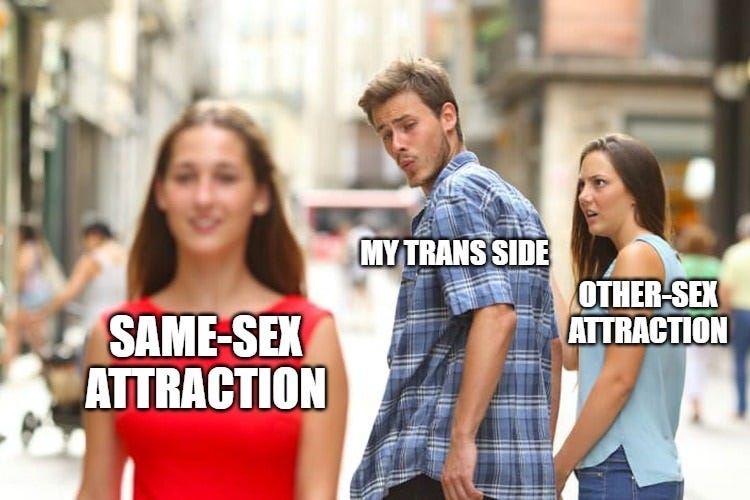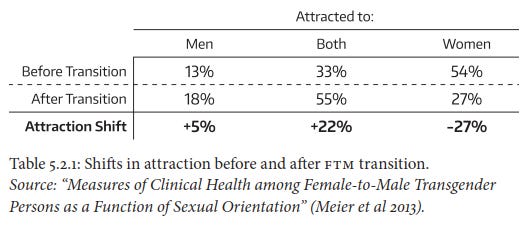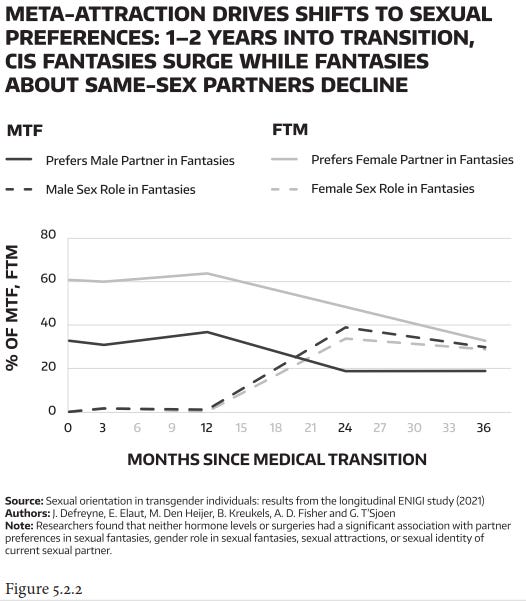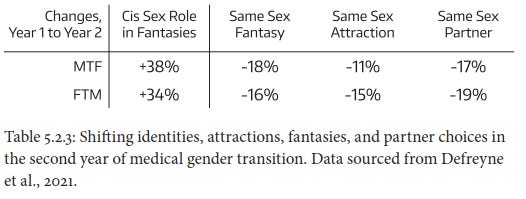Many transgender people report that their sexual preferences changed after they transitioned gender.
Some trans women who only ever had eyes for women report that men started to become attractive after they transitioned. Some trans men who thought they were only into women say that gay and bisexual men began to draw their attention after transitioning.
For some, their sexual preferences shifted when they adopted a transgender identity or started hormones. For others, it may have started when they socially transitioned or started passing. Depending on the individual, the timing varies.
In order to better understand this phenomenon, the authors of a 2013 paper on sexual orientation in trans men used an internet survey to ask approximately 500 trans men about their attractions before and after transitioning (identification, social transition, or medical transition)[i].
An astounding 40% of these trans men reported shifts in attraction after transitioning. Most shifted toward interest in men. Testosterone usage didn’t predict changes to sexual orientation[ii], which suggested that hormonal changes weren’t behind these shifts.
Remember the autoandrophilic FTM developmental trajectory I mentioned previously[iii] in which an autoandrophilic trans man may ultimately come out three times?
(1) lesbian/bi woman → (2) trans man → (3) gay/bi trans man
The shifts in sexual preference reported in this study suggest that this identity development sequence is a recurring pattern among autoandrophilic trans men.
Realistic Researchers Address Autoheterosexuality
A year later, in 2014, another group of researchers published a paper on trans people’s sexual orientation changes, but this time they drew from a clinical population[iv]. Like previous researchers, they found that reported changes in sexual orientation weren’t associated with taking hormones[v]. These changes weren’t associated with surgeries, either, or even the age when participants started to feel dysphoria, take hormones, or transition socially[vi].
None of these factors seemed to have a significant impact.
To make sense of their findings, these researchers seriously considered the possibility that these changes were related to autoheterosexuality.
They noted how written responses from study subjects suggested autoheterosexuality was behind many of the reported changes in sexual orientation. They also reviewed past studies presenting both qualitative and quantitative evidence for the existence and relevance of autoheterosexuality[vii].
These researchers noted that their heterosexual transsexuals were most likely to report a change in sexual orientation, and suggested their true orientation was actually autoheterosexual[viii]. They also advised that “researchers should explicitly ask for autogynephilic and autoandrophilic sexual orientation”[ix].
Unfortunately, researchers rarely follow this sane and rational advice.
Meta-Attraction Influences Sexuality Shifts
A network of gender professionals in Europe have coordinated their actions in order to research transgenderism and gender variance in larger cohorts across different European countries.
The group they formed, the European Network for the Investigation of Gender Incongruence (ENIGI), carried out a three-year longitudinal study of transgender people. With 902 participants at the start, the study had a massive sample size[x].
As part of this research, participants were asked about 1) their sexual attractions, 2) their sexual fantasies, 3) the sexual identity of their current partner, and 4) which sex role they played in their sexual fantasies. They were asked this same set of questions just before starting hormones, three months later, and then after one, two, and three years[xi].
Just like the prior studies, the researchers didn’t find any effect of hormones or surgeries on sexual orientation outcomes[xii]. At this point, it seems fairly established that hormones or surgeries don’t directly cause the sexual orientation changes that trans people commonly report after transitioning.
However, meta-attraction can account for many of these changes. Since autohet meta-attraction can drive a desire to play a cross-gender sex role with a same-sex partner (meta-homosexuality), it’s likely that meta-attraction is behind many of the reported changes in sexual orientation.
Between the check-ins at years one and two, trans men and trans women both reported a large increase in sexual fantasies in which they played a sex role associated with their birth sex. If meta-attraction drives the changes to sexual orientation that trans people report, we’d expect them to report fewer sexual fantasies about people of the same sex over this same period.
That’s exactly what happened: fantasies about people of the same sex decreased.
This change wasn’t limited to fantasies, either. These shifts also showed up in reported sexual attractions and even affected their choice of sexual partner (see Table 5.2.3). For both trans women and trans men, measures of same-sex interest declined across the board. It wasn’t as large as the decline in cross-gender fantasies, but that’s to be expected: only a subset of autoheterosexuals experience meta-homosexuality.
Interpreting these research findings with the awareness that autoheterosexuality is the most common cause of transgenderism makes the pattern blatantly obvious, but these researchers didn’t even mention autogynephilia or autoandrophilia. And for some strange reason, they presented their findings as a series of truly awful bar charts that obscured the pattern.
The first time I read this study, I saw no clear takeaways. Neither the charts nor the discussion that followed them seemed to indicate any noteworthy patterns. But a few months later, I entered the data into a spreadsheet, plotted it as a line graph, and the pattern jumped out.
It was obvious. As cross-gender sexual fantasies plummeted, so did same-sex fantasies, attractions, and partner choices. Meta-attraction was behind these changes.
It’s not as if the researchers were oblivious to the existence and relevance of autoheterosexuality, either: the very first citation in their paper pointed to the study I discussed in the previous section in which the authors explored the relevance of autoheterosexuality for several pages and explicitly advised other researchers to ask study subjects about autoandrophilia and autogynephilia[xiii].
When this ENIGI report came out, it represented the largest study of sexual orientation changes in trans people ever conducted. Its sample size absolutely dwarfed those of all previous similar studies, and it was the product of teamwork between researchers across several countries.
What is the likelihood that this team of transgender health professionals forgot to consider the most common kind of transgenderism when they interpreted and wrote up their findings? Is it likely that none of these researchers noticed this curious pattern of same-sex interest declining in tandem with cross-gender fantasies?
Chapter 5.2 Recap:
Trans people commonly report changes to their sexual orientations around the time they undergo gender transition, but empirical studies have repeatedly found these changes aren’t associated with hormones or surgeries. Something else is behind them.
Research results from the massive ENIGI study suggest that meta-attraction can account for these reported changes in sexual orientation. During the same time period that trans people reported a dramatic drop in sexual fantasies in which they played a cross-gender sex role, there was a corresponding drop in sexual interest toward people of the same sex—a change that showed up in their fantasies, attractions, and partner choices.
Speak With Me
Are you an autosexual person who wants to discuss your experiences with someone who actually understands what it’s like? Are you in a relationship with an autosexual person and want to understand them better?
[i] Meier et al., “Measures of Clinical Health among Female-to-Male Transgender Persons as a Function of Sexual Orientation.”
[ii] Meier et al., 470.
[iii] Rowniak and Chesla, “Coming Out for a Third Time.”
[iv] Auer et al., “Transgender Transitioning and Change of Self-Reported Sexual Orientation.”
[v] Auer et al., 5.
[vi] Auer et al., 6.
[vii] Auer et al., 8–10.
[viii] Auer et al., 10.
[ix] Auer et al., 10.
[x] Defreyne et al., “Sexual Orientation in Transgender Individuals,” November 2021.
[xi] Defreyne et al., 3.
[xii] Defreyne et al., 6.
[xiii] Defreyne et al., 8; Auer et al., “Transgender Transitioning and Change of Self-Reported Sexual Orientation.”









Conservation of heterosexuality...
I just watched the episode with Benjamin Boyce and I have to say I have the upmost respect for Phil and have NO interest in a gay man representing my views as to whether Phil’s attire or demeanor is offensive to me. What I found offensive is the gay man speaking for me or any other woman!